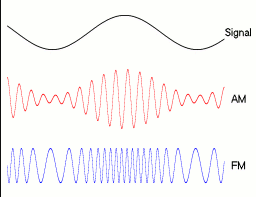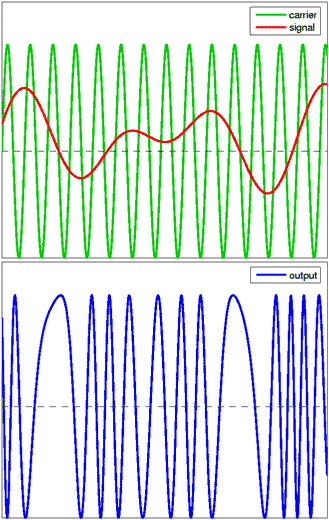Originally published in 2018 on the BDX radio club website, this article has been thoroughly revised and adapted to provide a concise, engineering-level introduction to radio modulation — a core concept in both amateur and professional wireless systems.
Modulation is a fundamental pillar of all radio communication technology. Whether used to transmit voice, digital data or complex signals, it allows information to be imprinted onto a carrier wave so that it can be transmitted efficiently over a radio channel.
This article provides an overview of the different modulation techniques, how they work, their applications and the criteria influencing their choice. This content is part of a series of technical articles dedicated to the fundamentals of transmission, intended for curious minds and enthusiasts, whether amateurs or professionals.
Why do we talk about modulation in radio?
All transmission systems, whether analogue or digital, are based on a fundamental principle: modulation. This process allows information (voice, data, images, etc.) to be superimposed onto a radio carrier wave so that it can be transmitted under the physical conditions of a propagation channel.
Without modulation, it would be impossible to transmit a useful signal on a specific frequency or protect it from transmission-related distortions.
This involves varying certain characteristics of a carrier signal (amplitude, frequency or phase) according to the information to be transmitted. In particular, it allows:
- The signal to be adapted to the transmission channel
- The impact of noise or distortion to be reduced
- The bandwidth and overall performance of the system to be optimised
According to the Larousse dictionary, it is a process by which a characteristic quantity of an oscillation is forced to follow the variations of a modulating signal. In simple terms, it is the way in which information shapes the radio signal.

The three main types of modulation
Modulation acts on a characteristic of a carrier wave: its amplitude, frequency or phase. There are three main types of modulation:

Amplitude modulation (AM): As its name suggests, this type of modulation aims to vary the intensity or amplitude of the carrier signal. A graphical representation of the modulated signal and its components is shown below.
Amplitude modulation was the first type of modulation used to broadcast sound. Although other types of modulation have since appeared, amplitude modulation is still widely used.

Frequency modulation (FM): This type of modulation involves varying the frequency of the carrier signal according to the modulating signal (the information). A graphical representation of the frequency-modulated signal is shown below.
Frequency modulation has the advantage that amplitude variations do not transmit any information about the signal. Attenuation or noise affecting the amplitude will therefore be eliminated in the receiver by smoothing the amplitude. This type of modulation is more robust and has therefore been used for many applications such as high-quality analogue radio broadcasting.
Illustration : wikipedia

Amplitude modulation (AM): As its name suggests, this type of modulation aims to vary the intensity or amplitude of the carrier signal. A graphical representation of the modulated signal and its components is shown below.
Amplitude modulation was the first type of modulation used to broadcast sound. Although other types of modulation have since appeared, amplitude modulation is still widely used.
Illustration : wikipedia
Each of these types of modulation has its own advantages and disadvantages and, as a result, they are all used in different radio communication applications, as explained at the beginning of this article.
In addition to these three main types of modulation, there are other types that are variants of these. The use of each of these types of modulation will depend on the application in question and its use case.
These techniques may be more suitable in analogue or digital applications.
Angle modulation
Angle modulation is a name given to forms of modulation based on changing the angle or phase of a sinusoidal carrier. When using angle modulation, there is no change in the amplitude of the carrier.
The two forms of modulation that fall into the category of angle modulation are:
- frequency modulation
- phase modulation.
They are both related because frequency is the derivative of phase, i.e. frequency is the rate of change of phase.
Another way to view the relationship between the two types of modulation is that a frequency-modulated signal can be generated by first integrating the modulating waveform and then using the result as input to a phase modulator.
Conversely, a phase-modulated signal can be generated by first differentiating the modulating signal and then using the result as input to a frequency modulator.
Modulation combinations
It is possible to use modulation forms that combine amplitude and angle modulation components. This can result in improved performance. Examples include:
- quadrature amplitude modulation (QAM in the literature, mainly English-speaking): a signal in which two carriers offset by 90 degrees are modulated and the resulting output includes amplitude and phase variations. Since amplitude and phase variations are present, they can also be considered a mixture of amplitude and phase modulation.
- Amplitude and phase shift keying (APSK): this is a digital modulation scheme that uses both amplitude and phase changes in the carrier signal to provide the data transport mechanism.
This type of modulation has a number of features and advantages that can solve problems encountered with quadrature phase shift keying and amplitude shift keying techniques, for example.
Signal bandwidth
An important element of any signal is the bandwidth it occupies and, consequently, the number of channels that can be integrated into a given segment of the radio spectrum. With the increase in the use of the radio spectrum (think of 5G, Lora, Sigfox, etc., which are eating into the free portions of the spectrum), bandwidth is becoming an increasingly important consideration.
The bandwidth of a radio signal is an important characteristic of any type of radio broadcast or transmission.
Bandwidth is governed by two main considerations:
- the type of modulation: Some forms of modulation use their bandwidth more efficiently than others. This means that the choice of modulation type may be dictated by spectrum occupancy.
- The bandwidth of the modulating signal: a physical (dare I say natural?) law called Shannon’s law determines the minimum bandwidth through which a signal can be transmitted. In general, the wider the bandwidth of the modulating signal, the greater the required bandwidth of the modulated signal.
Modulating signal type
In addition to the modulation form itself, the type of signal used to modulate the carrier also has an impact on the signal.
Analogue and digital signals are two very different forms of modulation signals and must be treated differently. Although different modulation formats can be used, the type of signal applied via the modulator also influences the signal.
Signals for high-quality stereo broadcasting will be processed differently from signals providing digital telemetry, for example. Therefore, it is often important to know the type of signal to be carried by the RF carrier.
Understanding modulation means understanding how information travels.
From simple voice transmission to complex high-speed data streams. Whether you’re designing a robust IoT network or experimenting with a home-built transceiver, mastering these principles opens the door to resilient and optimized communication systems

